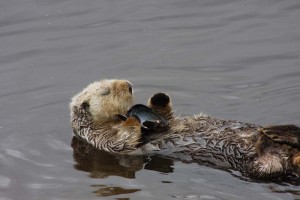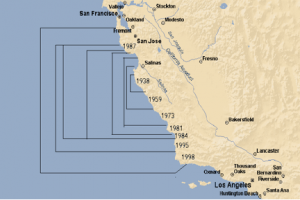
Southern sea otters (Enhydra lutris nereis) were not always present in Monterey Bay, and over the last 150 years have occupied, vacated, and re-occupied the bay often thought of as synonymous with the charismatic marine mammal.
In 1938 a small colony of southern sea otters (Enhydra lutris nereis) were “discovered” at Bixby Creek on California’s rugged Big Sur Coast. From that time, there are a variety of anecdotal notes about when sea otters may have returned to Monterey Bay after a prolonged absence. Although there are no known precise records of when sea otters became re-established within Monterey Bay, the general consensus is that it was well underway by 1965.
There was little systematic monitoring of either sea otters or their prey species before 1960. In 1956, Dick Boolootian monitored behavior of sea otters in Big Sur near Rocky Point, and was one of the first individuals to document otters’ voracious appetites for sea urchins, abalone, and mussels. Boolootian observed a raft of 50 sea otters consume upwards of 90 sea urchins a day, and in the late 1950s took note of the disappearance of urchin beds south of Carmel, while urchin beds near Hopkins Marine Station and China Point remained fully intact. Jim McLean (1962) provides some of the best “before” documentation of invertebrate populations in the area at the time.
Slowly the otters “ate their way” north, reaching the exposed shores of Pebble Beach and Pacific Grove around 1960 before turning into the calmer waters of the bay. A group of young males are believed to have been the first to round Point Pinos in 1962, likely in search of abundant urchins and red abalone. It didn’t take long for more to follow. By April 1963, some sources report that there was a raft of 75 otters off China Point, the beginning of the colony that still exists today (Palumbi and Sotka 2011). However, sea otter expert Dr. Jim Estes was at Hopkins in the summers of 1959-1960 and in the summer and fall of 1964, and does not recall otters there during any of those years. When Estes returned to Hopkins in 1969, otters were present, suggesting they had populated the area in the years in between (J. Estes, personal communication).

By feasting on sea urchins, sea otters facilitated the transformation of the previously urchin-dominated system into the current Macrocystis kelp forests, which had been absent for decades. Dr. Jim Estes recalls this change:
“In 1959-60, there were luxuriant kelp forests, but only in small patches, mainly on the pipes bringing sardines in from the hoppers. We had to row out from Hopkins to those small patches of kelp to collect animals from them. I recall snorkeling off of Agassiz Beach on the east side of Hopkins in 1959 or 1960, and the barren bottom was purple from the cover of sea urchins. There were also lots of subtidal red abalone, and the black abalones were so dense you could hardly walk on the rocks.
When I started my kelp forest ecology class at Hopkins in the summer of 1971 there was a luxuriant kelp forest right off Hopkins that we could study. Sea urchins and abalones were restricted to cracks and crevices. There were plenty of crabs, snails, and other prey of sea otters, and there still are” (J. Estes, personal communication).”
In his 1971 M.S. thesis on the ecology of kelp beds off Del Monte Beach, Charles Minter observed:
“Though no observations were made during this study of what otters were eating in the Del Monte kelp beds, divers found ample evidence to indicate that a once extensive abalone population had been annihilated. Numerous shells of the red abalone (Haliotis rufescens) were observed littering the bottom, yet not a single living animal was seen. In addition, no living specimens of the red urchin, Strongylocentrotus franciscanus, and very few of the smaller purple urchin, S. purpuratus, were observed.”
Records of abalone harvested by skindivers shows that 7500 red abalone were taken in this area in 1960 compared to 75 in 1972. Yet even after the otters had returned, substantial densities of both sea urchins and abalone were documented within southern Monterey Bay. As observed by Estes, abalone were usually smaller in size, and both abalone and urchins were fewer in number and almost entirely restricted to deep, narrow interstices where sea otters could not remove them. This would have restricted the abalone to feeding on drift algae, rather than foraging in the open, and it is possible that competition for suitable crevice space became intense. These otter-induced changes may have contributed to a long-term trend of greater abundance of Macrocystis kelp and decreased abundance and density of Nereocystis kelp, although there is evidence (discussed in Miller and Geibel, 1973) that this transition was occurring at spatial and temporal scales beyond the scope of otter range expansion.
An estimated vanguard of 50-150 young otter pioneers continued north in the early 1960s, although the sandy middle third of Monterey Bay’s coast – largely lacking the invertebrate prey found in areas with rocky substrate – was thought to serve as a biogeographic break. The northern peripheral group of males reached Soquel Point near Santa Cruz around February 1977 (Riedman and Estes 1990). Some of the otters that ventured further north were likely attacked by white sharks in the vicinity of Año Nuevo, which may have contributed to the slowing of their northward expansion. With time, sea otters gradually expanded their range to the north and south, although they still have not reached San Francisco Bay (Fig. 2). By 2012, dozens of sea otters regularly occupy the inlet area of Elkhorn Slough, right in the middle of Monterey Bay and the sandy middle third of the bay.
The slow rate of southern sea otter range expansion can likely be attributed largely to the low rate of population growth exhibited by the subspecies. The theoretical maximum rate of growth for sea otter populations is 17-20% a year. Other populations, such as those in Alaska and Washington, have averaged a rate of 9% a year, while the southern sea otter population increased at a rate of only 4-5% a year from the early 1900s until the 1970s (Riedman and Estes 1990).
For More Information:
Lowry, L. F. and J. S. Pearse. 1973. Abalones and sea urchins in an area inhabited by sea otters. Marine Biology 23: 213-219.
McLean, J. 1962. Sublittoral ecology of kelp beds of the open coast areas near Carmel, California. Biological Bulletin of the Woods Hole Marine Biological Laboratory 122: 95-114.
Miller, D. J. and J. J. Geibel. 1973. Kelp Bed – Invertebrate – Sea Otter Interactions. In Summary of blue rockfish and lingcod life histories, a reef ecology study, and giant kelp, Macrocystis pyrifera, experiments in Monterey Bay, California. California Department of Fish and Game, Sacramento, California.
Palumbi, S. R. and C. Sotka. 2011. The Death & Life of Monterey Bay: A Story of Revival. Washington: Island Press.
Reidman, M. L. and J. A. Estes. 1990. The Sea Otter (Enhydra lutris): Behavior, Ecology, and Natural History. Biological Report 90(14), U.S. Fish and Wildlife Service. 126pp.
Wild, P. W. and J. A. Ames. 1974. A Report on the Sea Otter, Enhydra lutris, in California. California Department of Fish and Game Marine Resource Technical Report #20.